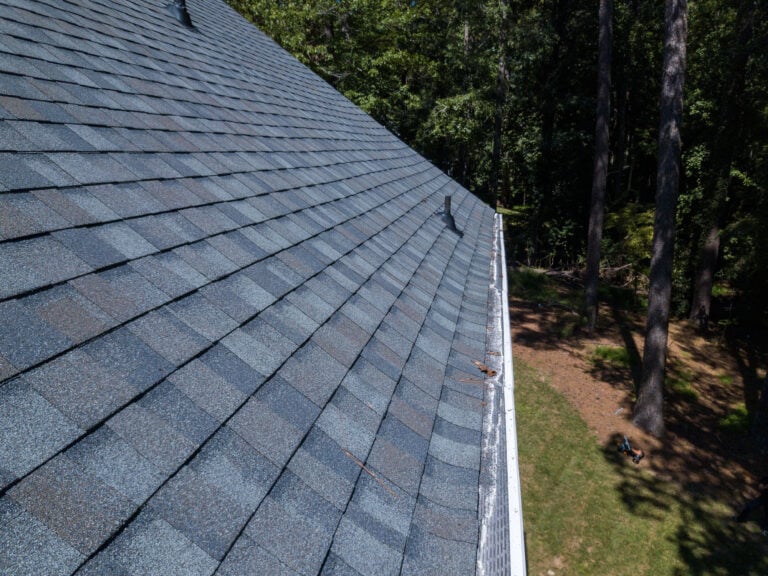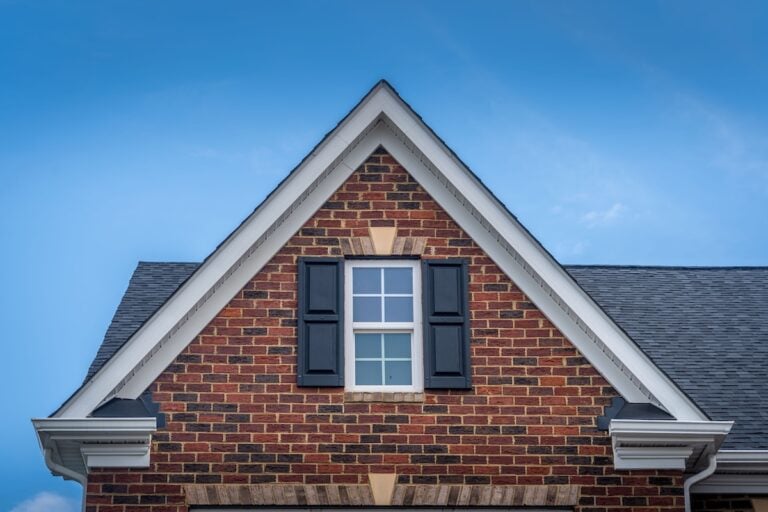It’s time to talk about something we don’t often think about until it’s too late: our roofs. Specifically, how those pesky strong winds can wreak havoc on them. But don’t worry, we’ve got you covered (pun intended). In this blog, we’ll explore eight signs of roof damage caused by those powerful gusts.
Key insights from this blog:
- The top 8 signs that your roof has been hit by some serious winds
- What to do once you’ve found roof damage
Want to stay ahead of the storm when it comes to roof damage? Start scrollin’!
How to Spot Wind Damaged Shingles: 8 Things to Look For
Do you suspect you are dealing with roof damage? Look for these signs.
1. Your Shingles Look Out of Place or Are Missing 🧩

One of the most obvious signs of wind damage is when your roof’s shingles decide to play musical chairs. If you notice that some shingles have gone AWOL, you have curling shingles, or they’re just flat out missing, it’s time to investigate. The wind can easily lift and displace shingles, leaving your roof vulnerable to water damage.
Water can infiltrate your home, leading to issues like rot, mold, and structural damage. And the thing about water is that it doesn’t need much of an opening; even the tiniest gap can result in significant problems over time.
So, if you ever find yourself in a situation where your roof’s shingles are engaging in an impromptu game of musical chairs, it’s not something to take lightly. It’s a clear signal that your roof’s ability to protect your home has been compromised. In such cases, prompt investigation and repair are essential to prevent further damage and keep your home cozy and dry.
Remember, your roof is your shield against the elements, and it deserves a little TLC in return for all it does to protect you and your family.
2. There Are Cracks and Tears in Your Shingles ⚡
Strong winds can be relentless, and they don’t just stop at shingle displacement. They can also create cracks and tears in your roofing materials. Inspect your roof for any visible damage, such as cracks in the shingles or tears in the flashing around vents and chimneys. Even small cracks can lead to big problems if left unaddressed.
3. The Gutters Have Become Clogged 🍃
In the battle against strong winds, one of the primary battlegrounds is your gutters. Wind can be quite the mischief-maker, carrying leaves, twigs, and all sorts of debris into your gutters. As it accumulates, this debris can obstruct the flow of rainwater, turning your gutters into a cluttered, inefficient mess.
But that’s not the end of the story. It’s not just about the inconvenience of clogged gutters; it’s also about the potential damage to your roof. When gutters are clogged, rainwater can overflow and spill over the sides, drenching your roof in the process. This excess moisture can seep into your roof’s structure, causing damage over time. So, while it may seem like a minor inconvenience, those clogged gutters are actually part of a larger problem that can impact your roof’s longevity.
4. Your Ceilings Show Water Stains 💧

If your roof has been compromised by strong winds, it’s likely to start leaking during the next rain shower. Keep an eye out for water stains on your ceiling or walls, as well as any drips or puddles in your attic. These are all telltale signs that you may be facing roof repairs or a roof replacement.
5. The Soffit and Fascia Are Deteriorating 🏚️
Soffits and fascia are those often overlooked parts of your roof that can also suffer wind damage. Check for cracks, peeling paint, or other signs of deterioration on these components and other roofing materials too. Damaged soffits and fascia can lead to bigger problems if not addressed promptly.
6. The Roofline Has Begun to Sag 〰️
A sagging roofline is more than just a cosmetic concern; it’s a glaring sign that your roof may be in serious trouble. When your roof starts to exhibit this unfortunate drooping or sagging appearance, it’s not merely a matter of aesthetics but rather a clear indication that structural damage has occurred.
Why is a sagging roofline a serious concern? Well, aside from the obvious aesthetics, there’s also a considerable weight of responsibility that your roof carries. It must support not only the roof covering materials but also withstand the elements, like rain, snow, and yes, those strong winds we’re discussing. When structural damage occurs, it weakens the roof’s ability to bear this weight. Over time, this can lead to further damage, including leaks, cracked shingles, and even a potential roof collapse in extreme cases.
7. Your Flashing Has Become Loose 🛠️
Flashing is the material that seals the seams and joints in your roof to prevent leaks. Strong winds can loosen or damage flashing, leaving vulnerable areas exposed and putting you in need of a major roof repair. Inspect your flashing and replace or repair it as needed to maintain your roof’s integrity.
8. You Experience Indoor Drafts and Temperature Extremes 🌡️
Sometimes the signs of roof damage are more subtle. If you notice drafts, uneven temperatures, or a sudden increase in your energy bills, your roof may be compromised. Poor insulation due to wind damage can wreak havoc on your home’s comfort and energy efficiency.
Speaking of energy costs, keep a close eye on your utility bills. A sudden and unexplained spike in your heating or cooling expenses could be an indication that your roof is not doing its job in maintaining your home’s energy efficiency. Poor insulation caused by wind damage can force your HVAC system to work harder, consuming more energy and leaving you with higher monthly bills.
What to Do if You Suspect Roof Damage

If you notice any of the above 8 signs, it’s very possible you have roof damage due to crazy winds or storm damage. So, what next?
Below are a few tips to help you take care of your roof after the wind blows:
- Safety First ⛑️ : Before you climb up on your roof or attempt any repairs, ensure your safety. If you’re unsure or uncomfortable, it’s best to hire a professional roofing contractor.
- Inspect Attic 🔎 : When we say “check your attic,” we’re not just talking about a quick glance up the ladder with a flashlight in hand. You need to put on your detective cap and inspect your attic for signs of leaks, moisture, or daylight seeping through the roof. These are red flags.
- Take Photos 📷 : Document the damage with photos. This will be helpful for insurance claims or when seeking professional help.
- Call the Pros📱: When in doubt, reach out to a professional roofing company. They have the expertise and equipment to assess and repair the damage correctly.
- Contact Your Insurance 🏡 : If the damage is extensive, contact your homeowner’s insurance company to discuss potential coverage for repairs or replacements.
- Preventative Measures 🛟 : Consider investing in preventive measures like wind-resistant shingles or roof reinforcements to protect your home from future wind damage.
How to Repair Wind Damage to Roof Systems
Wind can be one of the most damaging weather elements for any roof system. High winds can lift shingles, break them, or even tear them off completely. If left unchecked, this damage can lead to leaks and more extensive structural damage. Repairing wind damage promptly can save you time, money, and stress in the long run. Here’s a step-by-step guide to help you repair wind-damaged roofs.
Step 1: Assess the Damage
Before you begin any repairs, it’s crucial to assess the extent of the damage. Safely climb onto your roof or use binoculars from the ground to inspect for:
- Missing Shingles: Look for any areas where shingles are completely missing.
- Loose or Lifted Shingles: Check if any shingles are lifted or partially detached.
- Cracked or Broken Shingles: Watch out for visible cracks or broken pieces.
- Damaged Flashing: Inspect the metal strips around chimneys, vents, and other roof penetrations.
Step 2: Gather Your Tools and Materials
You’ll need specific tools and materials to repair wind damage effectively. Here’s a checklist:
- Replacement shingles
- Roofing nails
- Hammer
- Roofing adhesive or sealant
- Pry bar
- Utility knife
- Ladder
- Safety gear (gloves, goggles, harness)
Step 3: Remove Damaged Shingles
Carefully remove the damaged shingles to make way for new ones:
- Loosen the Adhesive: Use a utility knife to cut through any adhesive holding the damaged shingles in place.
- Remove Nails: Slide a pry bar under the shingle to lift it and remove the nails. Be cautious not to damage the surrounding shingles.
- Lift the Shingles Above: You may need to temporarily lift the shingles above the damaged ones to access and remove all nails.
Step 4: Install Replacement Shingles
Once the damaged shingles are removed, it’s time to install the new ones:
- Position the New Shingle: Slide the new shingle into place, ensuring it aligns with the surrounding shingles.
- Nail it Down: Secure the new shingle with roofing nails. Place nails about 1 inch above the cutout slots and 1 inch in from each edge.
- Seal the Shingles: Apply roofing adhesive or sealant to the nail heads and the edges of the new shingle to add extra hold and protection.
Step 5: Secure Loose Shingles
If you find any loose or lifted shingles that aren’t completely damaged, you can secure them back in place:
- Apply Adhesive: Lift the shingle slightly and apply roofing adhesive underneath.
- Press Down: Firmly press the shingle back into place to adhere it to the roof.
- Nail if Necessary: In some cases, you may need to add roofing nails to secure particularly loose shingles. Apply adhesive over the nails to seal them.
Step 6: Inspect Flashing and Other Components
High winds can also damage flashing and other roof components:
- Reattach Loose Flashing: Use roofing nails and adhesive to secure any loose flashing.
- Replace Damaged Flashing: If the flashing is severely damaged, replace it with new pieces cut to size.
- Seal Gaps: Apply roofing sealant to any gaps or exposed areas to prevent water intrusion.
Step 7: Perform a Final Inspection
After completing the repairs, perform a thorough inspection to ensure everything is secure and properly sealed. Look for:
- Any remaining loose or lifted shingles
- Properly sealed nail heads
- Secure and intact flashing
Keep Your Roof Safe From The Crazy Winds
Your roof may not be something you think about daily, but it’s a critical component of your home’s structure. And when it comes to wind damage, prevention and early detection are key.Keep an eye out for these eight signs, and don’t hesitate to take action if you suspect any damage. Remember, your roof is your home’s first line of defense against the elements, so keeping it in tip-top shape is essential. Stay safe, and may your roof weather all storms with flying colors!
Give us a call to speak with one of our experts at Palladium Roofing. We’re happy to come out and make sure your roof is protecting your home sufficiently.





